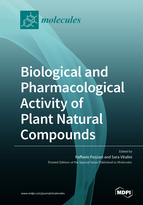Biological and Pharmacological Activity of Plant Natural Compounds
A special issue of Molecules (ISSN 1420-3049). This special issue belongs to the section "Natural Products Chemistry".
Deadline for manuscript submissions: closed (31 August 2020) | Viewed by 65789
Special Issue Editors
2. Associazione Italiana per la Ricerca Oncologica di Base, Padova, Italy
Interests: plant medicinal chemistry; phytotherapy research; oncology; preclinical research; endocrinology
Special Issues, Collections and Topics in MDPI journals
Interests: crop protection; plant diseases; bioactivity; phytochemistry; ethnopharmacology; natural products
Special Issues, Collections and Topics in MDPI journals
Special Issue Information
Dear Colleagues,
Plants are a rich source of numerous compounds with potential effects on living organisms, including animals and humans. Plants produce secondary metabolites that help plants in their survival. These metabolites are strongly involved in the potential therapeutic effects of plants for humans and are the basis of more than one-third of current drugs. Secondary metabolites are also lead compounds useful as a basis for synthetic modification and optimization and represent an excellent opportunity for the pharmaceutical industry. Furthermore, especially in developing countries, plants are a precious source of medicine, as they are collected in the wild or cultivated. Even if they are traditionally used and well known for their therapeutic properties, plants retain an infinite reserve of complex molecules. Indeed, many therapeutic properties of plants are yet to be discovered, despite the intense efforts of the scientific community.
An awareness of the importance of plants in disease treatment is rapidly emerging. In this regard, a rigorous scientific approach is the way forward for in-depth exploration.
This Special Issue aims to uncover novel, unconventional, alternative, and original properties of plant-derived compounds with a distinctive emphasis on biological and pharmacological activities. Moreover, phyto-complex (chemical compounds derived in full from plants) synergic effects. Reviews investigating plant product effects and/or describing the state of art are welcome, considering the increasing role of plant-derived molecules in daily use.
Prof. Raffaele Pezzani
Dr. Sara Vitalini
Guest Editors
Manuscript Submission Information
Manuscripts should be submitted online at www.mdpi.com by registering and logging in to this website. Once you are registered, click here to go to the submission form. Manuscripts can be submitted until the deadline. All submissions that pass pre-check are peer-reviewed. Accepted papers will be published continuously in the journal (as soon as accepted) and will be listed together on the special issue website. Research articles, review articles as well as short communications are invited. For planned papers, a title and short abstract (about 100 words) can be sent to the Editorial Office for announcement on this website.
Submitted manuscripts should not have been published previously, nor be under consideration for publication elsewhere (except conference proceedings papers). All manuscripts are thoroughly refereed through a single-blind peer-review process. A guide for authors and other relevant information for submission of manuscripts is available on the Instructions for Authors page. Molecules is an international peer-reviewed open access semimonthly journal published by MDPI.
Please visit the Instructions for Authors page before submitting a manuscript. The Article Processing Charge (APC) for publication in this open access journal is 2700 CHF (Swiss Francs). Submitted papers should be well formatted and use good English. Authors may use MDPI's English editing service prior to publication or during author revisions.
Keywords
- Plant secondary metabolites
- Natural compounds
- Biological activity
- Pharmacological activity
- Phytocomplex effects
- Plant medicinal chemistry
- Phytotherapy and natural medicine








